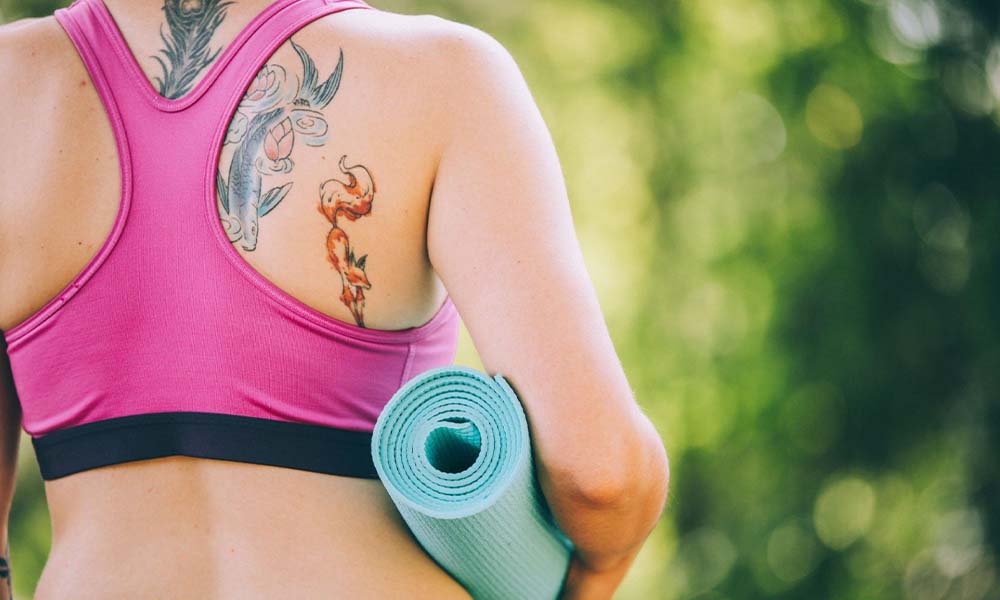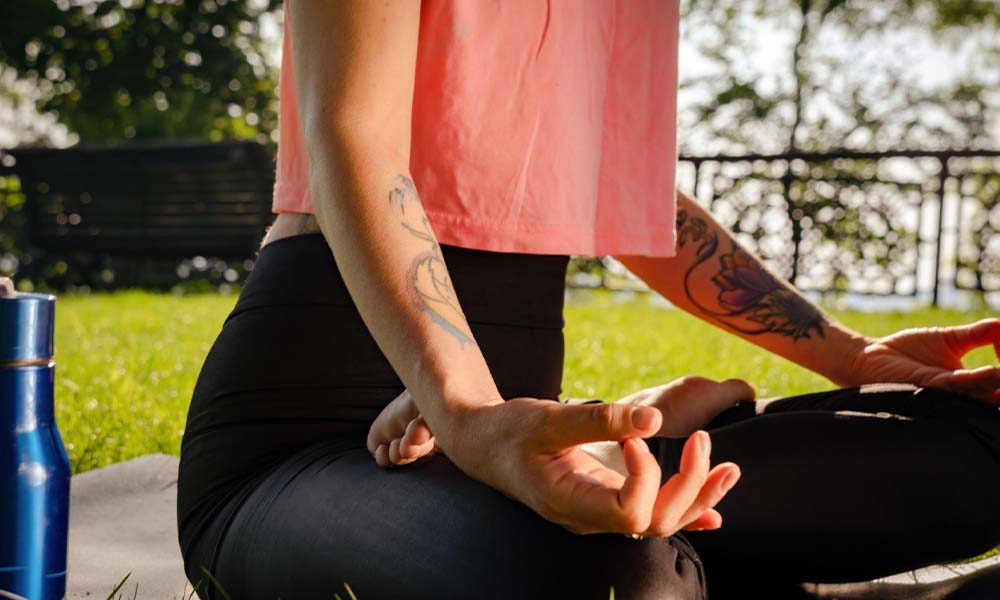Getting a tattoo is an exciting and personal experience that allows us to express ourselves through art. However, it is important to remember that a tattoo is essentially an open wound, and proper care is crucial to ensure its healing and longevity. One common concern among tattoo enthusiasts is whether they can continue their fitness routines and work out with a new tattoo. In this article, we will explore the tattoo healing process, factors to consider before working out, the risks and precautions associated with exercising with a fresh tattoo, best practices for tattoo-friendly workouts, and how to take care of your tattoo post-workout.
Table of Contents
ToggleUnderstanding the tattoo healing process

Before we delve into the topic of working out with a new tattoo, it is essential to have a basic understanding of the tattoo healing process. After getting a tattoo, your skin undergoes a series of stages to heal and recover. Initially, your tattoo will be covered with a protective layer called a tattoo bandage or wrap. This wrap should be kept on for several hours as it allows the tattoo to breathe and protects it from bacteria and other external factors.
After removing the initial wrap, you will need to wash your tattoo gently with mild soap and warm water. It is crucial to avoid scrubbing or rubbing the tattoo, as this can cause irritation and slow down the healing process. Once clean, you should pat the tattoo dry with a clean towel and apply a thin layer of tattoo aftercare ointment recommended by your tattoo artist. This ointment helps to keep the tattoo moisturized and aids in the healing process.
Factors to consider before working out with a new tattoo
Working out with a new tattoo is not a decision to be taken lightly. There are several factors that you should consider before engaging in any physical activity. Firstly, it is important to assess the location of your tattoo. If your tattoo is in an area prone to excessive movement or friction during exercise, such as the inner arm or thigh, it may be best to avoid vigorous workouts until the tattoo has fully healed. Additionally, if your tattoo is large or covers a significant portion of your body, it may be more susceptible to irritation and damage.
Another crucial factor to consider is the type of workout or exercise you plan on doing. High-intensity activities that involve a lot of sweating, rubbing, or stretching can be particularly risky for a new tattoo. These activities can cause the tattoo to become irritated, resulting in prolonged healing time and potentially affecting the final outcome of your tattoo. It is advisable to consult with your tattoo artist or a healthcare professional before continuing with your usual workout routine.
Can you workout with a fresh tattoo?

The answer to whether you can work out with a fresh tattoo is not a simple yes or no. It depends on various factors, such as the size and location of your tattoo, the intensity of your workout, and the stage of the healing process. In general, it is best to avoid working out with a new tattoo for at least the first few days. This allows the tattooed skin to settle and reduces the risk of excessive movement or friction that can disrupt the healing process.
Once the initial healing period has passed, you can gradually reintroduce physical activity into your routine. However, it is crucial to listen to your body and pay attention to any signs of discomfort or irritation. If you experience pain, excessive redness, or swelling during or after a workout, it is essential to stop and give your tattoo more time to heal. Remember, the healing process may vary from person to person, so it is crucial to be patient and prioritize the health of your tattoo.
Risks and precautions of working out with a new tattoo
Working out with a new tattoo poses several risks that can compromise the healing process and the overall quality of your tattoo. One of the primary risks is excessive sweating. Sweating excessively during a workout can cause the tattoo to become overly moist, which creates an ideal environment for bacteria to thrive. This can increase the risk of infection and prolong the healing time. To minimize this risk, it is essential to keep the tattoo as dry as possible during exercise by wearing loose, breathable clothing and avoiding activities that cause excessive sweating.
Another potential risk is friction and irritation. Certain exercises, such as weightlifting or activities that involve repetitive rubbing against the tattooed area, can cause the skin to become irritated and slow down the healing process. To minimize this risk, it is advisable to modify your workout routine to avoid exercises that directly impact the tattooed area. For example, if you have a fresh tattoo on your arm, you may want to focus on lower body exercises until the tattoo has fully healed.
Best practices for exercising with a new tattoo

While working out with a new tattoo carries some risks, there are several best practices you can follow to minimize these risks and ensure the successful healing of your tattoo. First and foremost, it is crucial to maintain good hygiene. Before and after each workout, make sure to clean the tattooed area gently with mild soap and warm water. Avoid using harsh or scented products that can irritate the skin. After cleaning, pat the tattoo dry with a clean towel and apply a thin layer of tattoo aftercare ointment recommended by your tattoo artist.
It is also important to choose the right clothing and accessories for your workouts. Opt for loose-fitting, breathable clothing that allows air circulation and minimizes friction against the tattoo. Avoid tight or restrictive clothing that can rub against the tattooed area and cause irritation. Additionally, consider using a clean towel or a barrier cream to protect the tattoo from excessive sweating or rubbing. This can help to maintain a clean and dry environment, reducing the risk of infection and promoting proper healing.
Taking care of your tattoo post-workout
After completing your workout, it is crucial to take proper care of your tattoo to ensure its health and longevity. Start by gently cleaning the tattooed area with mild soap and warm water to remove any sweat, dirt, or bacteria that may have accumulated during exercise. Pat the tattoo dry with a clean towel and apply a thin layer of tattoo aftercare ointment to keep the skin moisturized and aid in the healing process.
It is important to note that excessive washing or applying too much ointment can be detrimental to the healing process. Follow the instructions provided by your tattoo artist or consult with a healthcare professional to determine the best aftercare routine for your specific tattoo. Additionally, avoid exposing your tattoo to direct sunlight or soaking it in water, such as swimming pools or hot tubs, until it has fully healed. These actions can increase the risk of infection and fade the colors of your tattoo.
Common myths about working out with a new tattoo debunked
There are several myths and misconceptions surrounding the topic of working out with a new tattoo. Let’s debunk some of the most common ones to provide you with accurate information and guidance.
Myth 1: Exercising with a new tattoo will help it heal faster. Fact: Exercising does not speed up the healing process of a tattoo. In fact, excessive movement and sweating can hinder the healing process and increase the risk of infection.
Myth 2: Applying petroleum jelly or coconut oil to a new tattoo before working out protects it. Fact: Petroleum jelly and coconut oil can create a barrier that traps bacteria and sweat, increasing the risk of infection. It is best to follow your tattoo artist’s aftercare instructions and avoid applying any additional products before working out.
Myth 3: It is safe to work out with a new tattoo as long as you cover it with a bandage. Fact: While covering a new tattoo with a bandage may provide some protection, it is not foolproof. Bandages can trap moisture and heat, creating an environment conducive to bacterial growth. It is essential to follow proper aftercare routines and avoid working out until the tattoo has fully healed.
Tattoo-friendly workouts and exercises

If you are eager to maintain your fitness goals while allowing your tattoo to heal, there are several tattoo-friendly workouts and exercises you can engage in. Low-impact activities, such as yoga, Pilates, or walking, are generally safe options that minimize excessive movement and rubbing against the tattooed area. These exercises provide a gentle way to stay active without compromising the healing process.
Another tattoo-friendly workout option is swimming, but only after your tattoo has fully healed. Swimming in chlorinated pools or natural bodies of water can introduce bacteria and chemicals to your tattoo, increasing the risk of infection and fading. It is advisable to wait until your tattoo has completely healed before taking a dip in the water.
Frequently Asked Questions
Can I work out with a new tattoo?
Working out with a new tattoo is generally safe, but caution is necessary. Follow aftercare instructions and consider the tattoo’s location and the type of workout.
How long should I wait before exercising after getting a new tattoo?
It’s advisable to wait at least 48 hours before resuming exercise. This allows the initial healing process and scab formation to progress, reducing the risk of infection or damage.
Are there specific workouts I should avoid with a new tattoo?
High-intensity and contact sports, as well as exercises that involve excessive friction or stretching of the tattooed area, should be avoided during the initial healing phase to prevent scarring or ink loss.
Should I cover my new tattoo while working out?
Covering your new tattoo with a breathable, clean bandage or clothing can help protect it from sweat, dirt, and friction during workouts, reducing the risk of infection or irritation.
How can I prevent infection while working out with a new tattoo?
Maintain good hygiene, avoid touching your tattoo with dirty hands, and use a clean, breathable cover when working out to minimize the risk of infection. Follow your tattoo artist’s aftercare instructions diligently.
Can I apply sunscreen to my new tattoo before outdoor workouts?
Yes, applying sunscreen with at least SPF 30 to your healed tattoo is recommended when working out outdoors. Sun protection helps prevent fading and keeps your tattoo looking vibrant.
When is it safe to resume full-intensity workouts after getting a new tattoo?
You can gradually return to your regular workout routine once your tattoo has fully healed, which typically takes 2-4 weeks. However, always listen to your body and prioritize your tattoo’s health during the healing process.
Conclusion
In conclusion, working out with a new tattoo requires careful consideration and adherence to proper aftercare routines. While it is generally advisable to avoid vigorous workouts during the initial healing period, you can gradually reintroduce physical activity into your routine once your tattoo has settled and the risk of irritation is minimized. Remember to prioritize the health and longevity of your tattoo by maintaining good hygiene, choosing appropriate clothing, and following your tattoo artist’s aftercare instructions. By taking these precautions and being mindful of your tattoo’s healing process, you can continue to pursue your fitness goals while ensuring the optimal health of your new tattoo.


